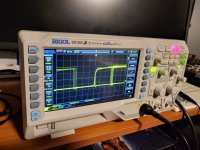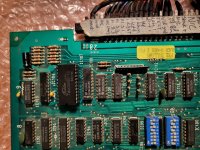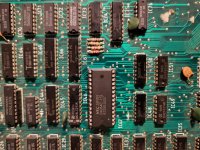skate323k137
Enlightened
Troubleshooting a bootleg Z80 arcade board, parts 1 and 2.
When I got this board it had 2 issues:
1- intermittent sync
2- certain pixels would remain on screen after being drawn, for an indeterminate amount of time.
About the board:
Z80 CPU
AY-3-8910 sound chip (basically a Yamaha YM2149)
NEC D4364 SRAM
Toshiba TMM2016BP SRAM
The rest of the board is almost entirely comprised of 74 / 74LS series logic ICs. Which honestly for repairing isn't the worst, except when they are all soldered in. And a ton of different brands were used.
Getting Started:
The Z80 CPU was definitely warm, so being the only socketed chip that wasn't game code EPROMs, I tried a new one in the socket to no luck. However the newer date code Z80 stayed cooler so I left it and moved on.
The biggest demonstrable issue was sync. This was causing the picture to drop out entirely on my blast city most of the time. I traced the JAMMA Sync pin all the way to the far side of the PCB, and found it coming from a 74LS86 labelled KOREA. In this picture, the blue wave is a signal coming into the gate that feeds sync. The yellow is the signal coming out... yes, that is bad.

I removed the 74LS86 IC since clearly the signal in is good and the signal out is bad. I installed a socket and new TI 74LS86, and to little surprise but much joy, the board sync'd right up. Here are the corrected sync output pulses, input channel no longer shown, showing 15.6Khz:

So it Syncs! Awesome! But then, I played a few rounds and noticed the aiming line (similar to the one sometimes seen in Puzzle Bobble) was leaving artifacts behind. You can see the stray pixels on the title screen after letting attract mode run a loop or two.... stuck pixels on a CRT
It should be all black background around the insert coin and copyright. The pixels which got stuck and how long they were stuck for were quite unpredictable.

At this point I removed, socketed, and replaced both SRAM ICs. It accomplished nothing, aside from letting me test a couple chips in each place to be absolutely sure it was not the RAM itself acting up. So I guess that does accomplish -something-.
At this point I shelved it for a while, like 6+ months. I got back around to it this weekend, and started probing IO lines on the RAM IC. This is the scope monitoring a single IO line on the Toshiba SRAM, and photos of both RAM areas.



I really didn't like the signals here, but I know from my last run at fixing this thing that the RAM IC I'm measuring this from is definitely good. So I resorted to an old school method of trying to gather some info, and started piggybacking LS logic chips (you can google this method if you want to know more). One at a time, I turned off the board, piggybacked an equivalent 74LS IC, and turned the board on. I started immediately adjacent to the Toshiba SRAM since I did not like the signals in that area. Piggybacking the 74ls245 made no difference. Most of the row was TI or National Semiconductor (read, reliable) chips, but the 74LS08 at the top, 2 chips from the SRAM, was the same brand as the KOREA chip that murdered the sync signal. I piggybacked it once and the board did not boot, so I cleaned the pins and tried it again, and the fault was 95% better. I immediately removed power, removed the bad 74LS08, and soldered in (you guessed it) a socket. Once I placed a good/new 74LS08 in the socket, and fired it up, the board runs 100% perfectly. Even for a bootleg made of off the shelf TTL Logic chips and ICs.

No stray pixels!
I hope you enjoyed the read, these kinds of things are worth learning to do yourself, but it won't be overnight. The most useful thing I did over the last year or two that allowed me to properly troubleshoot this board was build a hobby computer / RC2014 Z80 machine; ultimately I used the same CPU and sound chip as this JAMMA board uses. In this case the overall design being off the shelf components lended a hand to reparability, however, the issue with reliability was caused by the cheap ICs / mixture of manufacturers used by the bootleggers in the first place. In the end, I didn't find any faulty Zilog, TI, NEC, Toshiba, or National Semiconductor ICs, only the same cheap brand that ended up producing both faulty chips (and they were 2 different ICs! Just the same brand).
When I got this board it had 2 issues:
1- intermittent sync
2- certain pixels would remain on screen after being drawn, for an indeterminate amount of time.
About the board:
Z80 CPU
AY-3-8910 sound chip (basically a Yamaha YM2149)
NEC D4364 SRAM
Toshiba TMM2016BP SRAM
The rest of the board is almost entirely comprised of 74 / 74LS series logic ICs. Which honestly for repairing isn't the worst, except when they are all soldered in. And a ton of different brands were used.
Getting Started:
The Z80 CPU was definitely warm, so being the only socketed chip that wasn't game code EPROMs, I tried a new one in the socket to no luck. However the newer date code Z80 stayed cooler so I left it and moved on.
The biggest demonstrable issue was sync. This was causing the picture to drop out entirely on my blast city most of the time. I traced the JAMMA Sync pin all the way to the far side of the PCB, and found it coming from a 74LS86 labelled KOREA. In this picture, the blue wave is a signal coming into the gate that feeds sync. The yellow is the signal coming out... yes, that is bad.
I removed the 74LS86 IC since clearly the signal in is good and the signal out is bad. I installed a socket and new TI 74LS86, and to little surprise but much joy, the board sync'd right up. Here are the corrected sync output pulses, input channel no longer shown, showing 15.6Khz:
So it Syncs! Awesome! But then, I played a few rounds and noticed the aiming line (similar to the one sometimes seen in Puzzle Bobble) was leaving artifacts behind. You can see the stray pixels on the title screen after letting attract mode run a loop or two.... stuck pixels on a CRT

It should be all black background around the insert coin and copyright. The pixels which got stuck and how long they were stuck for were quite unpredictable.
At this point I removed, socketed, and replaced both SRAM ICs. It accomplished nothing, aside from letting me test a couple chips in each place to be absolutely sure it was not the RAM itself acting up. So I guess that does accomplish -something-.
At this point I shelved it for a while, like 6+ months. I got back around to it this weekend, and started probing IO lines on the RAM IC. This is the scope monitoring a single IO line on the Toshiba SRAM, and photos of both RAM areas.



I really didn't like the signals here, but I know from my last run at fixing this thing that the RAM IC I'm measuring this from is definitely good. So I resorted to an old school method of trying to gather some info, and started piggybacking LS logic chips (you can google this method if you want to know more). One at a time, I turned off the board, piggybacked an equivalent 74LS IC, and turned the board on. I started immediately adjacent to the Toshiba SRAM since I did not like the signals in that area. Piggybacking the 74ls245 made no difference. Most of the row was TI or National Semiconductor (read, reliable) chips, but the 74LS08 at the top, 2 chips from the SRAM, was the same brand as the KOREA chip that murdered the sync signal. I piggybacked it once and the board did not boot, so I cleaned the pins and tried it again, and the fault was 95% better. I immediately removed power, removed the bad 74LS08, and soldered in (you guessed it) a socket. Once I placed a good/new 74LS08 in the socket, and fired it up, the board runs 100% perfectly. Even for a bootleg made of off the shelf TTL Logic chips and ICs.
No stray pixels!
I hope you enjoyed the read, these kinds of things are worth learning to do yourself, but it won't be overnight. The most useful thing I did over the last year or two that allowed me to properly troubleshoot this board was build a hobby computer / RC2014 Z80 machine; ultimately I used the same CPU and sound chip as this JAMMA board uses. In this case the overall design being off the shelf components lended a hand to reparability, however, the issue with reliability was caused by the cheap ICs / mixture of manufacturers used by the bootleggers in the first place. In the end, I didn't find any faulty Zilog, TI, NEC, Toshiba, or National Semiconductor ICs, only the same cheap brand that ended up producing both faulty chips (and they were 2 different ICs! Just the same brand).

